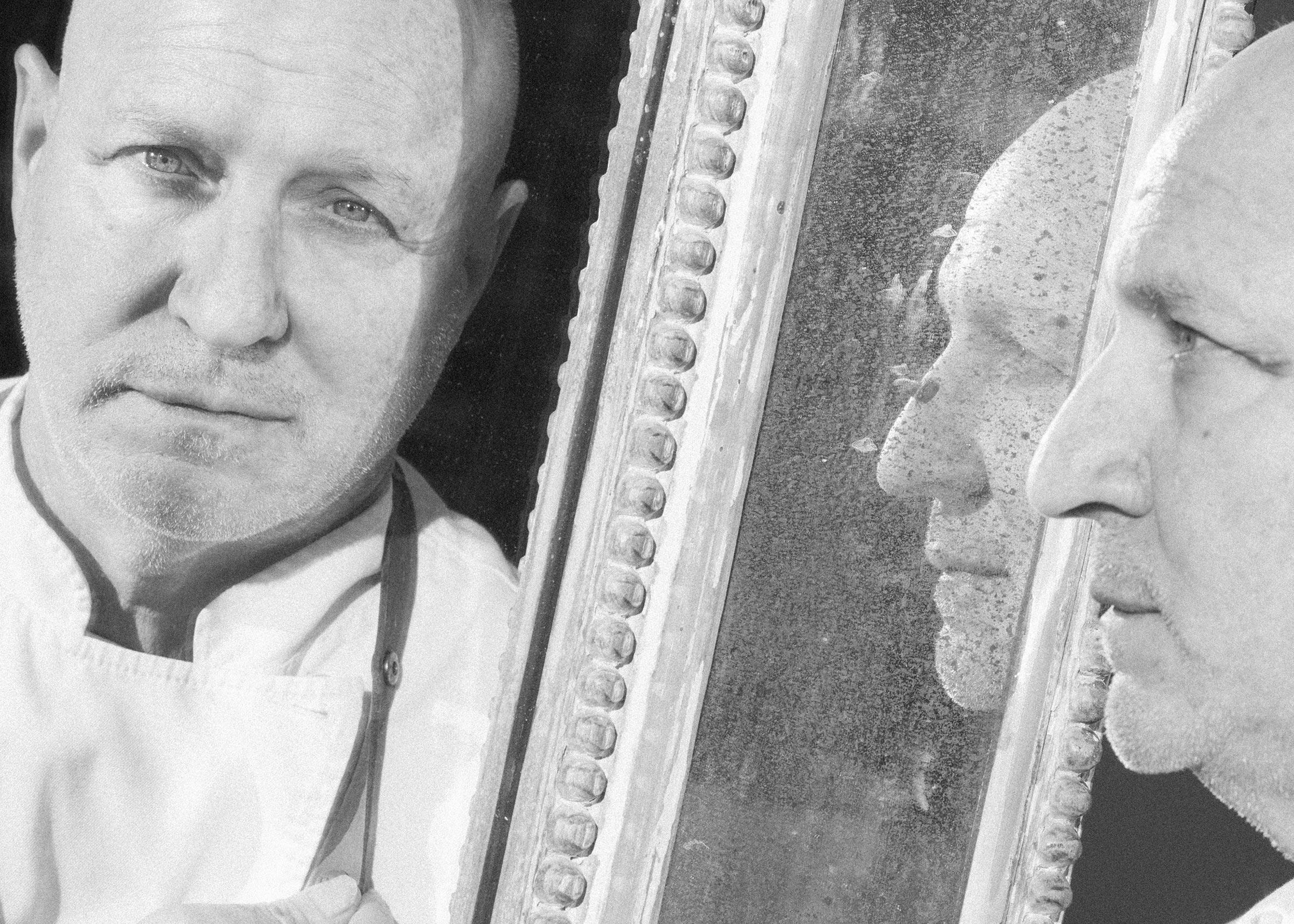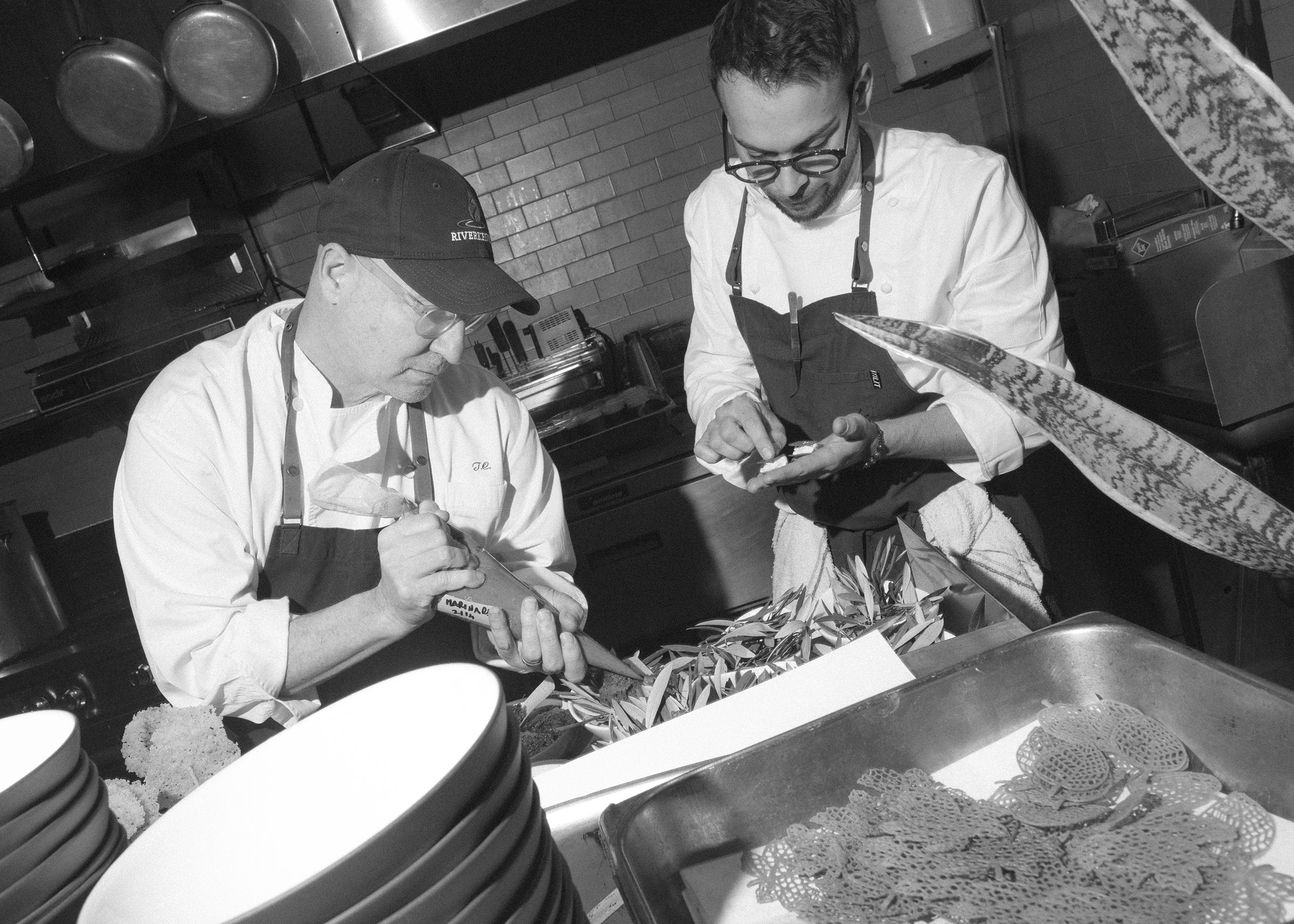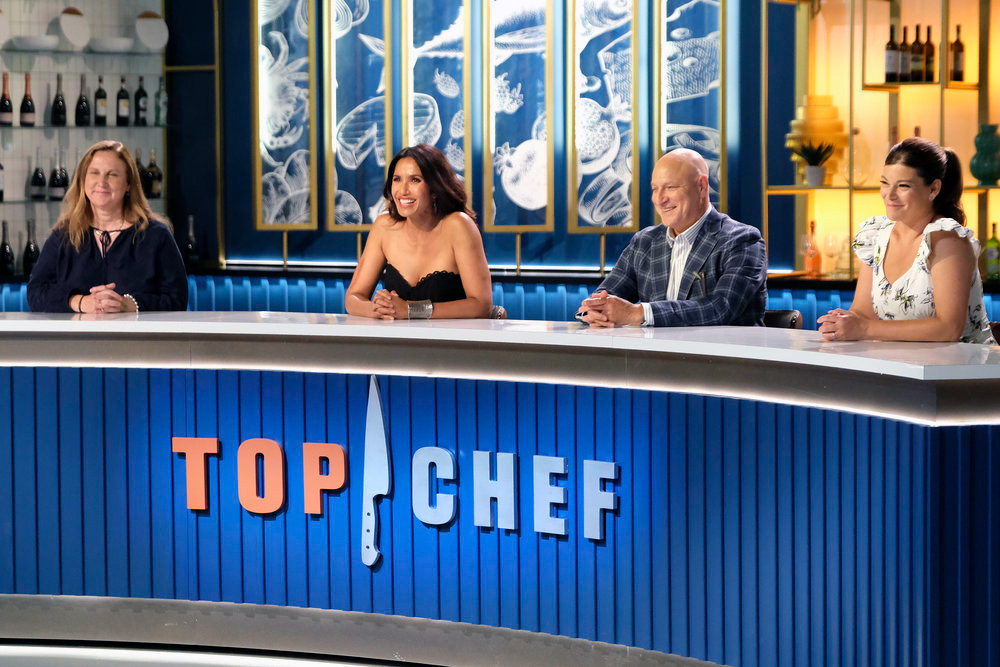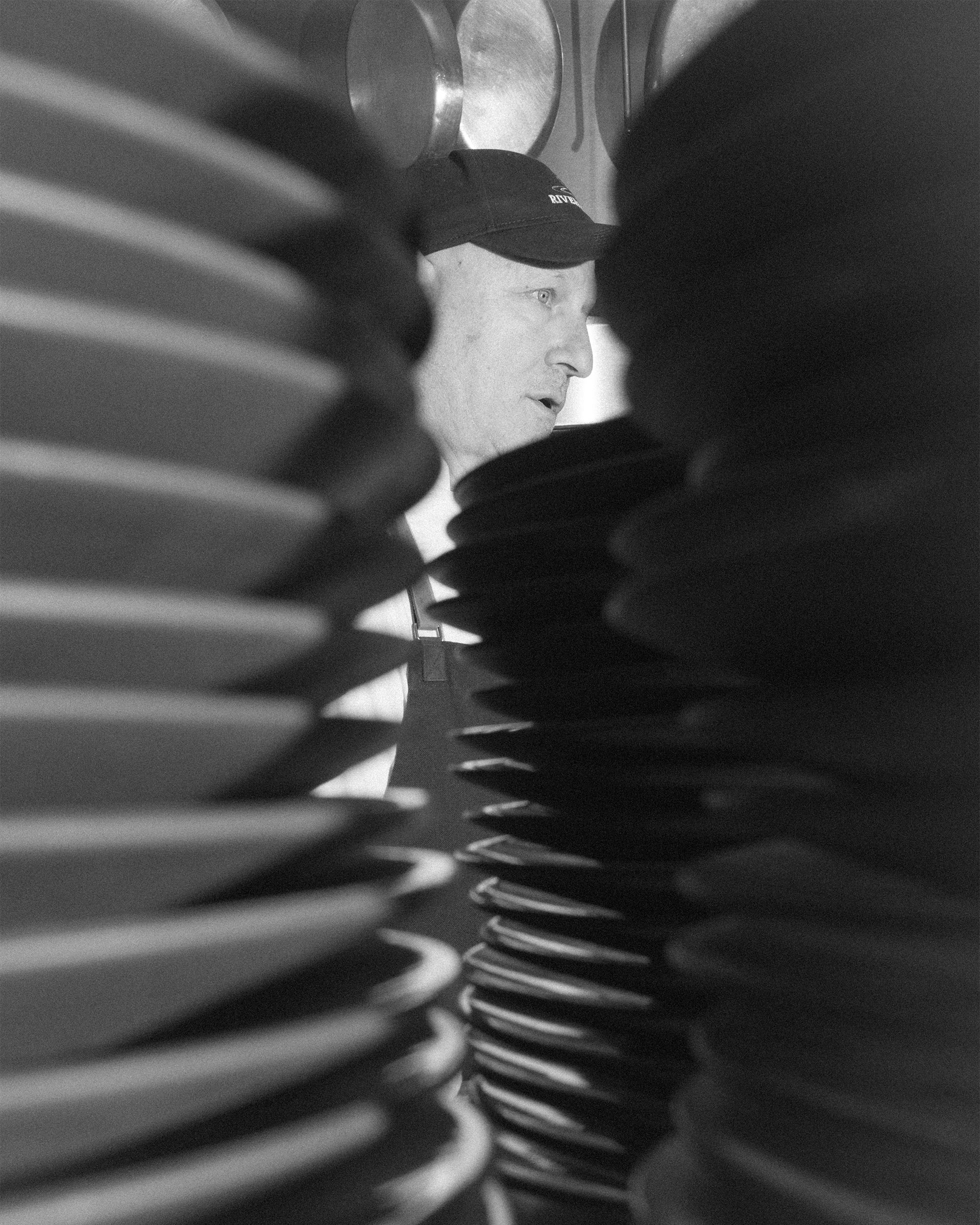
Tom Colicchio hovers over a farm table abutting the open kitchen in his Italian restaurant Vallata, calling out orders for sea urchin and whistling to the Motown hit “The Tears of a Clown” piping through the restaurant. A guest chef from Italy is cooking for a Valentine’s Day pop-up, and Colicchio, 60, who rarely works evenings anymore, is monitoring the dishes as they make their way to diners.
The night starts out slow, but as more customers sit, the cooks find themselves in the weeds. Colicchio rolls his eyes as he wipes sauce that’s oozing out from a dish of oxtail agnolotti. “The plate is too hot,” he says. “Yes, chef,” one of the cooks replies hastily. Colicchio doesn’t like the custom of cooks calling the boss “chef” in kitchens, but he doesn’t stop to correct him. Another plate emerges that doesn’t look quite right. “Yes or no, is it seasoned?” Colicchio asks. On his face is an expression familiar to fans of Top Chef, the award-winning reality competition show on which Colicchio is head judge: “I’m not mad, I’m just disappointed,” it says.
When I meet him before the dinner, in his office above Vallata and his famous high-end restaurant Craft, he does not seem particularly happy to be there either. A member of the old guard in the New York restaurant scene, Colicchio has overseen a transition in the food world from a macho, cutthroat culture to a gentler, more inclusive one. But seated behind a wood-slab desk surrounded by framed James Beard awards, he shakes his head dismissively at the idea that he has played a major role in that transformation. “We’re just reflecting the change that’s going on in the industry,” he says of the show.

Top Chef, which has been nominated for 42 Emmys and won two, will kick off its 20th season on March 9. To celebrate that milestone, the producers shot the full season overseas for the first time, in London, and invited former contestants from Top Chef competitions across the world—Top Chef France, Top Chef Brazil, Top Chef Middle East & North Africa, and eight other global iterations, including the U.S.—to compete with one another for $250,000. But the most coveted prize of Top Chef is not the money but an endorsement from what’s widely considered the most serious cooking competition on television. And who gets that seal of approval from the three judges—Colicchio, Gail Simmons, and Padma Lakshmi—has fundamentally shifted away from the bombastic white men who once dominated the show toward a more diverse group of chefs who succeed in the kitchen without screaming obscenities or punching refrigerators.
Read More: The Best Reality TV Seasons of All Time: Top Chef Season 18 (2021)
While Colicchio concedes that the show has helped secure cooks, especially female and BIPOC cooks, funding for restaurants they might not otherwise be able to get, he balks at the notion that he—or the show in general—is a kingmaker or queenmaker. “I can think of plenty of people who made it pretty far on the show who didn’t do so well in their careers, who flamed out,” he says, glancing impatiently at his phone. “We provide the platform. You still have to walk through the door and do something with it.”
Others who work on the show aren’t so quick to dismiss its impact. Simmons points to the fact that the show has produced some of today’s most successful chefs. Stephanie Izard (Season 4) runs the Girl & the Goat empire out of Chicago. Kwame Onwuachi (Season 13) wrote the memoir Notes From a Young Black Chef, which is being adapted into a film starring LaKeith Stanfield, and just opened an impossible-to-reserve restaurant in New York City called Tatiana. Gregory Gourdet (Seasons 12 and 17) won a James Beard award for his cookbook and is up for Best New Restaurant this year for Kann in Portland, Ore. “It sort of crept up on us. Those first few seasons, we sort of didn’t realize the power we would wield. We certainly do now,” Simmons says. “We do have their livelihoods in the palm of our hands.”

Colicchio in particular wields that power, or at least the contestants think so. As the only judge with his own restaurant empire, he is the one that the competitors most hope to impress. “Tom is a perfectionist. His restaurant is called Craft for a reason,” says Eric Adjepong, a Top Chef contestant on Seasons 16 and 17. “Gail and Padma also hold weight, but I think the swinging vote, the one that is the anchor of it all, is Tom.”
Food personalities with their own shows can grin and be effusive onscreen but secretly awful off-camera. Colicchio, by contrast, speaks brusquely yet seems to have leveraged his position as a powerful white man in the industry for good: He’s influential—his nod of approval helped launch an entire generation of young talent—but doesn’t want to admit it. He’s proud of his advocacy work but shrugs off the idea that he’s a leader in the industry. He thinks the show has changed for the better but grows defensive when asked about harsh feedback he’s given, insisting he has no regrets. His bluntness is off-putting yet refreshing.
“He is the quintessential chef-y chef,” says Simmons, “not necessarily the warm and fuzzy guy you want him to be until you get to know him.”
When Colicchio was first approached about the opportunity to judge Top Chef, he turned it down. He worried if it leaned into silly reality-show tropes, he would tank his reputation. He came up in the 1990s New York food world with the radical idea that a restaurant could serve local, fresh ingredients even if it wasn’t located in sunny California. Gramercy Tavern (which he opened with famed restaurateur Danny Meyer) and Craft helped set a trend of what we now call sustainable cooking. He was famous for shopping at the Union Square Greenmarket before every restaurant in the city was jockeying for produce at its stands.
He signed on to the first season after he was given assurances that the judges would get to make decisions without any producer interference. That mandate earned Top Chef its sterling reputation. Reality-show audiences can see if a designer sews an ill-fitting dress on Project Runway or hear a missed note on The Voice. They cannot taste or even smell the food being served on Top Chef. They must trust that the judges are sending someone home based on a flaw they’ll never be able to experience. If viewers suspected telegenic potential played a role in elimination decisions, they would lose all confidence in the series.
Read More: Cooking With Top Chef Host Padma Lakshmi Means Tasting Many Nations
Colicchio is notorious for his walk-throughs on Top Chef. While the cooks prep for a 200-person themed charity event or try to conjure up a plant-based menu for a vegetarian guest judge, Colicchio strolls through the kitchen peeking into pots. Innocent queries—“how long does it usually take you to cook that?”—send contestants spinning. They scrutinize his poker face and second-guess their instincts. “They are intimidated,” says Simmons. “I would be intimidated too because he’s paying attention.” Colicchio claims he doesn’t mean to disrupt contestants’ grooves, but the producers need him to prod so they can shoot the chefs’ reactions. “I’m doing those to help the story,” he says. “Quite frankly, I’d rather not do them.”

Doneen Arquines, who began as a production assistant on the first season and is now an executive producer, acknowledges that Colicchio can be an imposing presence but says his gravitas is the point. “Everybody really wants to please him. They want to crack his hard shell,” she says. “He doesn’t give a lot of clues away as to whether he likes something in the moment, so when he’s effusive about something, the chefs are like, ‘Holy crap, I really impressed Tom.’”
Early seasons of Top Chef often saw contestants fretting over the prospect of being pigeonholed: In confessionals they wondered if they cooked primarily Filipino or Indian dishes, would they lose to competitors showing off the classic French techniques they learned in culinary school? But what is considered award-worthy food has changed considerably over the course of the show’s 17-year run. “When I came up 40 years ago, the New York Times would only review a French restaurant or maybe an Italian restaurant. That was it. Asian restaurants weren’t getting reviewed. Mexican restaurants weren’t getting reviewed,” says Colicchio. “I didn’t have an Italian restaurant until about a year ago. I shied away from it because French is the cuisine that you thought you had to do to have an upscale restaurant.”
Top Chef’s focus has likewise shifted, and chefs have been rewarded for cooking refined versions of the food they grew up eating. “I think Gregory [Gourdet] is a great example,” says Arquines. “I couldn’t have named you a Haitian restaurant before this that’s getting the kind of accolades he’s getting.”

Still, navigating the complexities of race, identity, and food has at times landed the show in hot water. In 2020, Gourdet faced off against a white contestant named Kevin Gillespie in Restaurant Wars, an annual episode in which the chefs are tasked with opening competing restaurants. Gourdet’s Haitian concept, Kann, went up against Gillespie’s The Country Captain, inspired by what Gillespie called “the plantation South.” The concept did not go over well on social media, and Gillespie has since apologized for using the phrase.
One season prior, viewers had similarly taken issue with the way the judges spoke about Adjepong’s food. “I could have done modern American or Italian or French food, but I had a very specific goal to cook West African food, the food of the African diaspora, because I hadn’t seen it on the show in 16 seasons,” Adjepong says. “I had to find time to not only describe my dish but also to educate on why this is cooked this way. I didn’t see other chefs having to do that as much because the judges were familiar [with their food].”
I broach the topic of Adjepong’s food with Colicchio, and he jumps in before I can finish my question. “I don’t care what culture you are, if you burn garlic, it’s bitter and nasty,” he says of the dish that got Adjepong sent home. He goes on to criticize the concept behind it. “Quite frankly, this idea that you’re highlighting West African flavors and putting truffles on something? That doesn’t, I don’t know,” he trails off. “It was horrible. That’s why he lost.”
I clarify that I was hoping to ask about a stew dish from an earlier episode, and again he cuts me off, this time to litigate the type of seed Adjepong used. Adjepong was eliminated after serving just one course of his finale meal, the only meal on the show that the chefs can conceive of entirely themselves without restraints. Colicchio invited him to cook what would have been his entire menu at Craft. “The reason he did a pop-up here is because I got so much pushback saying we didn’t get to see his finale meal,” says Colicchio. “It’s like, ‘OK, well, cook it here.’”

Despite the online controversy, Adjepong is grateful to Colicchio. “So many amazing things have trickled off from that event,” he says of the pop-up. He now hosts the Food Network competition show Alex vs America. Still, he says, given that the new season of Top Chef, called the “World All-Stars” edition, will include a more international group of contestants, “I hope they do more to broaden the judges’ palates and bring in maybe more guest judges that have expertise on different cuisines.”
I ask Colicchio whether he worries that the lack of diversity on the judges’ panel means they can’t fairly judge everyone’s food. “Between the three of us and the other [guest] judges, there’s not a whole lot of cuisine we haven’t experienced,” he says. “So no.”
Top Chef has evolved in other ways over 20 seasons. The early years featured reality-TV gamesmanship with accusations of sabotage. Casual sexism was tossed off as some male chefs griped about being beaten “by girls.” Now, if contestants forget an ingredient or drop a plate, their fellow chefs pitch in to help. In part, it’s a public-relations gambit. “Too many chefs saw someone on the show who was just a complete asshole and was just like, ‘I’m not going to be that person,’” says Colicchio. “So I think they’re all keeping themselves in check.”
But it’s also a reflection of a change in restaurant culture. Several chefs and restaurateurs of Colicchio’s generation have left the spotlight after allegations of harassment or assault, as have a few Top Chef alumni. Colicchio sees those failures as a “top-down” problem where certain kings of the food scene were perpetrating abuses themselves and normalizing it in their kitchens. “If that’s how they’re going to act, it doesn’t bode well for anybody,” he says. Kitchens have become “softer,” he says, an improvement, “but you would still be shocked at the stupidity I see.”
I press for details. “With restaurants, people fraternize after work, in bars, hanging out late night drinking, and then stuff just goes bad. That’s not an excuse. It’s just a fact. This is what happens,” he says. “We stopped doing holiday parties because after a holiday party, I’d have to fire people. Someone just got out of line, and it’s like, ‘Enough of this. Just don’t provide the opportunity.’ We did away with staff drinks, too.”
Read More: Top Chef: Portland Was the Kindest Season Yet. Did the Finale Change That?
Sexual harassment isn’t the only plague of the industry. Debates about staff pay have dogged restaurants for years. The announced closure of René Redzepi’s Noma in Copenhagen, oft-named the best restaurant in the world, and the fact that Redzepi was relying on unpaid interns to produce his $500-per-customer tasting menu, sparked anew a conversation about the prevalence of unpaid and underpaid workers. While poverty wages are common across restaurant price points, the reliance on free labor in fine dining struck many as particularly hypocritical.
Colicchio dismisses the idea that the Noma model was unsustainable. “That’s not why they closed. René could have doubled his prices the following day and still sold out,” says Colicchio. “He burnt out. The subtext here is he was tired of doing what he was doing. It was taking a toll on him.” On the question of whether restaurants in general can be both sustainable and ethical, Colicchio quips, “I’ve been open here for 21 years. That’s sustainable.” He points out that prior to the pandemic, Craft’s cooks on average were making $18 per hour. Now they make $24 because of the high demand for labor in the industry.
Colicchio dedicated much of his time during the pandemic to keeping restaurants open. Already familiar with Capitol Hill because of his work on food sustainability and hunger, he co-founded the Independent Restaurant Coalition to lobby for federal funding. Colicchio lights up when we hit on his advocacy work. He and his fellow chefs were able to secure $48.6 billion for the industry. Turning Craft’s private dining room into the more casual Vallata, with paintings of cows and exposed brick walls, was also a pandemic project for Colicchio. Now Vallata is open and restaurants in New York are functioning basically normally again—albeit with ramshackle outdoor dining huts still outside.

Colicchio has remained an unwavering fixture on 19th Street, but it’s clear, at least the night of the pop-up, that what he really wants is to go home. Spending time cultivating his garden on his Long Island property with his family over the past few years has ruined him for the 70-hour weeks he used to work. Though he still has restaurants in New York, Los Angeles, and Las Vegas, he rarely ventures from his primary residence in Brooklyn to eat at local restaurants with his wife and would welcome a season of Top Chef set in that borough for convenience reasons. When I suggest Brooklyn has great restaurants the show could feature, he replies, “Brooklyn has good restaurants,” emphasizing “good” as a qualifier. (I’m sure lauded spots like Lilia, Bonnie’s, and Olmsted would like a word.)
His air of skepticism evaporates when we turn to the restaurant dramedy The Bear, which he discovered while flipping through the apps. How nobody told him about this show’s existence, he does not know, but he says it’s the most realistic rendering of working in a kitchen he’s seen on TV. He hated the movie The Menu, which he found unrealistic—and not just because of all the murder. He offers thoughts on why so many higher-end restaurants have been switching to tasting menus—workers’ shortage—and takes glee in teasing that Top Chef may finally eliminate the “front of house” position during Restaurant Wars this season. But mostly he seems eager to hightail it out of the restaurant after service is over.
And yet as much of a homebody as he’s become, Colicchio still looks forward to each seven-week stint filming a new season of Top Chef, where he has the chance to mentor young chefs and play guitar with the crew. “It’s like going to summer camp,” he says. “I’ll keep doing it until I stop enjoying it, and that’s not going to be anytime soon.”
More Must-Reads From TIME
- The 100 Most Influential People of 2024
- Coco Gauff Is Playing for Herself Now
- Scenes From Pro-Palestinian Encampments Across U.S. Universities
- 6 Compliments That Land Every Time
- If You're Dating Right Now , You're Brave: Column
- The AI That Could Heal a Divided Internet
- Fallout Is a Brilliant Model for the Future of Video Game Adaptations
- Want Weekly Recs on What to Watch, Read, and More? Sign Up for Worth Your Time
Write to Eliana Dockterman at eliana.dockterman@time.com